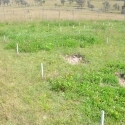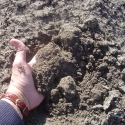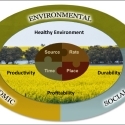20 Sep 2012
World Reserves of Rock Phosphate
Were are we really?
 Superphosphate granules 1
Superphosphate granules 1
Peak phosphorus – a real or perceived issue?
A reliable supply of high quality phosphorus (P) has been a cornerstone of agricultural development in Australia as well as across the globe. As most farmers know, P is an essential nutrient for plant growth that has no substitutes.
So, where P is lacking in the soil, large responses can be achieved by adding fertiliser P and ongoing production depends on at least replacing the P removed in produce. For example, a 3 t/ha wheat crop will remove around 10 kg of P which is the equivalent of 50 kg of MAP. Some cropping soils have reasonable soil P levels, but others are quite responsive to added fertiliser P.
P fertilisers such as MAP, DAP, triple super and superphosphate are made from phosphate rock that is mined mainly from ancient marine sediments as well as relatively new guano deposits and some igneous deposits. DAP and MAP represents around 70% of the P used in Australia (FIFA 2010). These deposits are finite resources and there has been some questions raised about the amount of P remaining for use.
The major producers of phosphate rock have been the United States and the former Soviet Union. Global production is again approaching the previous peak in the late 1980’s of around 210 million tonnes of rock per year.
The demand for phosphorus is strongest in East Asia and South Asia which use around half of the global P fertilizer, and these regions are also growing quickly. Use of fertilizer in general is also rising in Latin America. Australia uses around 945,000 t of P2O5 fertilizer annually (FIFA,2010), some which is produced from local phosphate rock and some which is imported or produced from imported rock. Australia also trades phosphate fertilizer internationally.
Van Vuuren et al. (2010) estimated that about half the current P resource would be depleted by 2100. An earlier estimate by Cordell et al. (2009) suggested that P fertiliser supply would peak in 2033 after which production would steadily fall. Because there is no agronomic substitute for P and much of the worlds food supply hinges on its use, having a reliable estimate of reserves is important in assessing how immediate is the problem of P resource depletion.
The size of the reserve of phosphate rock is an estimate of materials that can be economically produced at the present time using existing technology. The actual reserve base is the portion of the total reserve base (or resource) from which future reserves could be developed. Both terms are important as the reserve will change with technology and prices. As well, new deposits are discovered which adds to the resource base and reserve. These values of phosphate rock are expressed in terms of P2O5 content with most rock being around 25% to 35% P2O5.
The most recent comprehensive assessment of phosphate rock reserve and reserve base was undertaken by the International Fertilizer Development Centre (Van Kauwenbergh, 2010). The IFDC made by Van Kauwenbergh estimated global phosphate rock reserves of approximately 60 billion tonnes of concentrate which the US Geological Survey increased to 65 billion tonnes recently (USGS 2011) and more recently to 67 billion tonnes (USGs 2013).
Table 1 lists the annual production for 2009 and 2010 and an estimate of 2012 production for the major producers and the size of the current phosphate rock reserves. The IFDC estimate of global resources is approximately 290 billion tonnes.
Table 1 2 World Mine Production and Reserves (USGS 2011; USGS 2013)
| Country | 2009 (mt) | 2010 (mt) | 2012 (mt) | Reserves 2012 (mt) |
| Algeria | 1.8 | 2.0 | 1.5 | 2,200 |
| Australia | 2.8 | 2.8 | 2.6 | 490 |
| Brazil | 6.4 | 5.5 | 6.3 | 270 |
| Canada | 0.7 | 0.7 | 0.9 | 2 |
| China | 60.2 | 65.0 | 89.0 | 3,700 |
| Egypt | 5.0 | 5.0 | 3.0 | 100 |
| India | - | - | 1.3 | 6 |
| Iraq | - | - | 0.2 | 460 |
| Israel | 2.7 | 3.0 | 3.0 | 180 |
| Jordan | 5.3 | 6.0 | 6.5 | 1,500 |
| Mexico | - | 1.5 | 1.7 | 30 |
| Morocco | 23.0 | 26.0 | 28.0 | 50,000 |
| Peru | - | 0.8 | 2.6 | 820 |
| Russia | 10.0 | 10.0 | 11.3 | 1,300 |
| Saudi Arabia | 1.7 | 750 | ||
| Senegal | 0.7 | 0.7 | 1.0 | 180 |
| South Africa | 2.2 | 2.3 | 2.5 | 1,500 |
| Syria | 2.5 | 2.8 | 2.5 | 1,800 |
| Togo | 0.9 | 0.8 | 0.9 | 60 |
| Tunisia | 7.4 | 7.6 | 6.0 | 100 |
| United States | 26.4 | 26.1 | 29.2 | 1,400 |
| Other countries | 8.6 | 6.4 | 6.0 | 390 |
| World Total | 166.0 | 176.0 | 210 | 67,000 |
Australia has developed reserves of around 82 million tonnes of rock phosphate (USGS, 2011), which represents around 50 years supply based on current domestic use. There are also several companies involved in exploring and proving phosphate rock reserves and details can be found at http://www.australian-phosphate.com. The reserves given for Australia are estimated to be around 490 million tonnes.
There is significant activity in developing these resources. For example a new 5 million tonne per year phosphate rock mine began operation in Saudi Arabia late in 2010 and an associated fertilizer plant is due to open over the next few years. World mine production capacity was projected to increase to 228 million tonnes by 2015 through mine expansion projects in Algeria, Brazil, China, Israel, Jordan, Syria, and Tunisia, and development of new mines in Australia, Kazakhstan, Namibia, and Russia (USGS, 2011).
Over the past few years, production has been around 160 to 170 million tonnes of rock, and demand rose by 2.1% per year from 2007/2008 until 2011/2012 and is predicted to rise by around 3% annually until at least 2015 (Heffer and Prud’homme, 2011). Assuming current rates of production, IFDC estimates that there are sufficient phosphate rock concentrate reserves to produce fertilizer for several centuries at current rates of production.
This does not mean growers and the fertilizer industry should be complacent. Phosphorus is a non-renewable resource and using fertilizer best management practices to ensure efficient use of P is a critical component of wise nutrient stewardship. This will also include investigating strategies to recycle P as well as ensuring as much soil P is retained on farm by reducing soil erosion.
References:
Cordell D, J Drangert, S White (2009). The story of phosphorus: Global food security and food for thought. Global Environment Change 19, 292 - 305
Dorahy CG, IJ Rochester, GJ Blair (2004). Response of field-grown cotton (Gossypium hirsutum L.) to phosphorus fertilisation on alkaline soils in eastern Australia. Australian Journal of Soil Research, 42, 913 – 920.
FIFA (2010) 2009 Fertilizer sales statistics, The Fertilizer, Fertilizer Industry Federation of Australia (see http://www.fifa.asn.au/)
Fixen, P (2009) World fertilizer nutrient reserves – a view to the future. Better Crops, 93, 8-11.
Heffer P, M Prud’homme (2011) Fertilizer Outlook 2011 to 2015, 79th IFA Annual Conference, Montreal, May 2011 (see http://www.fertilizer.org/ifa/HomePage/LIBRARY/Conference-papers/Annual-Conferences/2011-IFA-Annual-Conference).
Van Kauwenbergh, S.J. (2010). World Phosphate Rock Reserves and Resources. International Fertilizer Development Centre, Muscle Shoals, Alabama.
Van Vuuren DP, AF Bouwman, AHW Beusen (2010). Phosphorus demand for the 1970–2100 period: A scenario analysis of resource depletion. Global Environmental Change 20, 428–439.
USGS (2011) Phosphate Rock. U.S. Geological Survey, Mineral commodity summaries January 2011 (p 118-119) On line at http://minerals.er.usgs.gov/minerals/pubs/mcs
Additional Resources
World Reserves of Rock Phosphate - a dynamic and unfolding storySize: 0.48 MB




